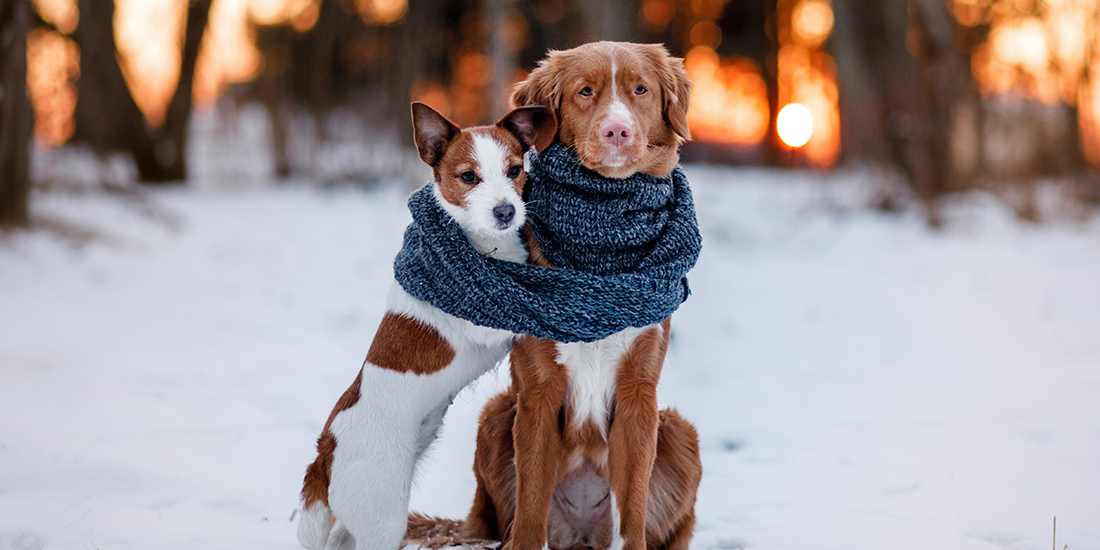[vc_row][vc_column][vc_column_text css=””]
Our canine companions, like us, are susceptible to the harsh realities of winter weather and it’s up to us to ensure they’re comfortable.
In this blog, we’ll answer the question “can dogs catch a cold from humans”, explore the factors that determine when it’s too cold for dogs, and delve into an unexpected but crucial aspect of their well-being – their diet. Specifically, we’ll examine the benefits of a raw food diet for dogs and how it can contribute to their overall health, especially in colder climates.
[/vc_column_text][/vc_column][/vc_row][vc_row][vc_column][vc_row_inner content_placement=”middle”][vc_column_inner width=”1/2″][vc_column_text css=””]
Understanding cold tolerance in dogs.
Canine breeds exhibit a wide range of tolerance to weather based on factors such as their size, coat type, and genetic adaptations, but do dogs get cold in winter? While it’s important to note that individual dogs may have varying levels of tolerance, certain breeds tend to handle colder weather better than others.[/vc_column_text][/vc_column_inner][/vc_row_inner][vc_row_inner content_placement=”middle”][vc_column_inner width=”1/2″][vc_column_text css=””]
Breeds that tend to handle colder weather well.
Northern breeds
Siberian Husky
Bred in harsh Siberian climates, Huskies have a thick double coat that provides insulation against cold temperatures.
Alaskan Malamute
Known for their strength and endurance, Malamutes have a dense coat that protects them from cold weather.
Bernese Mountain Dog
With a long, thick coat, Bernese Mountain Dogs are well-suited to colder climates.
Tibetan Mastiff
Originally bred to guard livestock in the Himalayas, Tibetan Mastiffs have a dense, weather-resistant coat.[/vc_column_text][/vc_column_inner][vc_column_inner width=”1/2″][vc_column_text css=””]

Working breeds
Newfoundland
These water rescue dogs have a water-resistant double coat that helps them stay warm in cold and wet conditions.
Saint Bernard
Known for their rescue work in the Swiss Alps, Saint Bernards have a thick coat to withstand cold temperatures.
Cold-climate hunting breeds
Norwegian Elkhound
Bred for hunting in the cold forests of Norway, Elkhounds have a dense, weather-resistant coat.
Chesapeake Bay Retriever
With a waterproof coat, Chesapeake Bay Retrievers excel in cold, aquatic environments.[/vc_column_text][/vc_column_inner][/vc_row_inner][vc_row_inner content_placement=”middle”][vc_column_inner width=”1/2″][vc_column_text css=””]
Breeds that may struggle in colder weather.
Toy breeds
Chihuahua
Small size and short coats make Chihuahuas more susceptible to cold weather. They may need extra protection in winter.
Short-haired breeds
Greyhound
Known for their thin coat and lean build, Greyhounds may require additional insulation in colder climates.
Dachshund
Short-haired Dachshunds may feel the cold more than their long-haired counterparts.[/vc_column_text][/vc_column_inner][vc_column_inner width=”1/2″][vc_column_text css=””]

Southern breeds
Italian Greyhound
This slender breed has a short coat and may need protection in cold weather.
Basenji
Originating from Africa, Basenjis have a short coat and may be less tolerant of colder temperatures.
Brachycephalic breeds
Bulldog, French Bulldog, and Pug
Breeds with flat faces may be more sensitive to extreme temperatures, including cold weather.[/vc_column_text][/vc_column_inner][/vc_row_inner][vc_row_inner content_placement=”middle”][vc_column_inner][vc_column_text css=””]
Signs that it’s too cold for your dog.
Are you wondering what temperature is too cold for dogs? Dogs, like humans, can experience discomfort and health issues when exposed to extreme cold. Watch for signs such as shivering, lethargy, and difficulty walking, as these may indicate that your furry friend is struggling to cope with the cold. If you notice these signs, it’s essential to take action to protect your dog from the chill.
[/vc_column_text][/vc_column_inner][vc_column_inner width=”1/2″][vc_column_text css=””]
Can dogs catch a cold from humans?
If you’re wondering can dogs get a cold, the answer is while dogs are susceptible to certain respiratory infections, the viruses that typically cause colds in humans differ from those that affect dogs. The common cold in humans is usually caused by rhinoviruses, while dogs can be affected by viruses such as canine coronavirus or canine parainfluenza virus. While there is some crossover between human and canine respiratory viruses, the transmission between species is not common.
If you’ve wondered “can dogs get a cold”, they can still experience respiratory infections that may have similar symptoms to a human cold, such as coughing, sneezing, and nasal discharge.
It is also possible for dogs to experience hypothermia. Signs of hypothermia in dogs include pale skin and gums, shivering, lethargy, whining, stumbling, lack of coordination, dilated pupils, low heart and breathing rates, and being curled up more often than normal. If you notice signs of hypothermia in your dog, promptly move them to a warm environment and wrap them snugly in a blanket. As a precaution advised by VRCC, consider placing warm water bottles strategically around the dog to maintain warmth, avoiding the use of a heating pad to prevent the risk of skin burns. Seek immediate veterinary attention by transporting your dog to a veterinarian or emergency vet hospital without delay.[/vc_column_text][/vc_column_inner][/vc_row_inner][vc_row_inner content_placement=”middle”][vc_column_inner width=”1/2″][vc_column_text css=””]
Cold remedies for dogs.
If your dog is experiencing any sort of respiratory illness or cold-like symptoms, it’s always best to have them checked out by your holistic veterinarian. Some simple DIY cold remedies to ensure they’re comfortable include:
Providing shelter and warmth.
To ensure your dog stays comfortable in cold weather, provide them with a warm, dry shelter. This can be a well-insulated doghouse or a cozy spot indoors. Additionally, consider using blankets or a heated bed to give your canine companion an extra layer of warmth. Dogs often appreciate a warm spot to retreat to when the winter winds howl.
The role of nutrition in cold weather.
Nutrition plays a critical role in helping dogs withstand the challenges of cold weather. A well-balanced diet can boost their immune system, maintain a healthy coat, and provide the energy needed to stay warm. One dietary approach that has gained popularity among pet owners is a raw food diet for dogs.
Bold By Nature raw pet food serves up meals for your dog, just as nature intended. These raw food diets for dogs involve feeding your pet meals that consist of uncooked and unprocessed ingredients and are free of artificial flavours and unnecessary fillers.
These diets mimic the natural diet of wild dogs, which typically eat prey animals and plants. Proponents of raw food diet for dogs believe that this type of diet is more natural and healthier for dogs than traditional kibble or canned dog food.[/vc_column_text][/vc_column_inner][vc_column_inner width=”1/2″][vc_column_text css=””]

Benefits of a raw food diet.
A raw food diet, also known as the BARF diet (Biologically Appropriate Raw Food), emphasizes feeding dogs a mix of raw meat, bones, fruits, and vegetables. Advocates argue that this diet closely mirrors what dogs eat in the wild, promoting overall health and well-being. In the context of cold weather, the raw food diet may offer several benefits:
Improved coat health
Bold by Nature raw dog food is rich in essential fatty acids, which may help contribute to a healthy and lustrous coat. A well-maintained coat acts as a natural barrier against the cold, helping dogs retain body heat.
Increased energy levels
Cold weather can be physically demanding on dogs, requiring more energy to stay warm. A Bold by Nature raw food diet is often considered more energy-dense than traditional dog food & kibble, and might assist in providing the fuel needed to keep active and maintain body temperature.[/vc_column_text][/vc_column_inner][/vc_row_inner][vc_row_inner content_placement=”middle”][vc_column_inner width=”1/2″][vc_column_text css=””]
Combining nutrition and environmental care.
The key to a healthy and happy dog during cold weather lies in the combination of proper nutrition and environmental care. Pay attention to your dog’s behavior and adjust their diet and living conditions accordingly. A well-fed and sheltered dog is better equipped to face the challenges of winter.
What if it’s too cold to walk a dog?
If the weather proves to be too cold for a good walk with your pup, consider providing your pet with a raw bone for some mental stimulation. Since the beginning of time, there’s been a connection between raw bones and dogs and as domesticated carnivores, that instinct to chew hasn’t changed one bit! The action of gnawing away at a bone is still very much ingrained in them and satisfies the urge for fun, especially when they can’t play outside.
[/vc_column_text][/vc_column_inner][vc_column_inner width=”1/2″][vc_column_text css=””]
Where can Bold by Nature products be purchased?
Bold by Nature can conveniently be purchased online or at a local retailer that carries our products! If you’re not sure if your local shop carries our products, you can use our handy location finder to find out. If you have any other pet-related questions, like “what foods cause hot spots on dogs” or “is grass good for dogs”, feel free to contact us!
[/vc_column_text][/vc_column][/vc_row]












